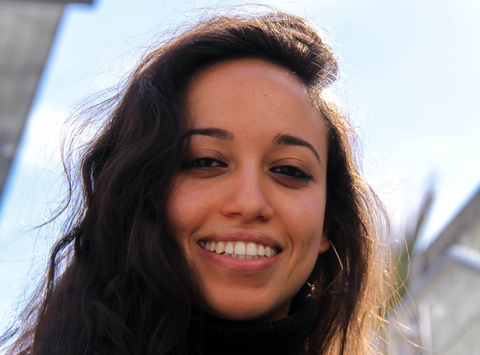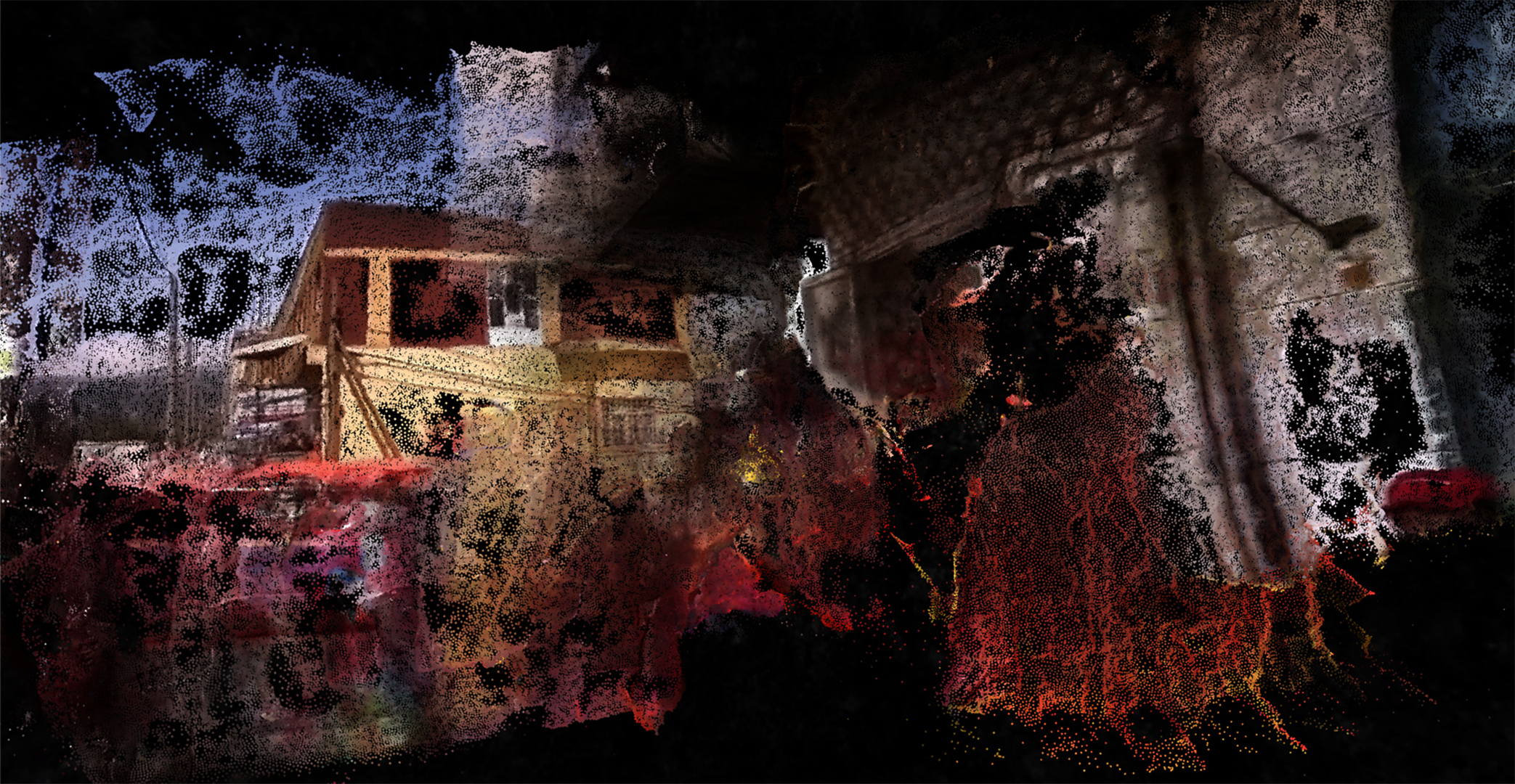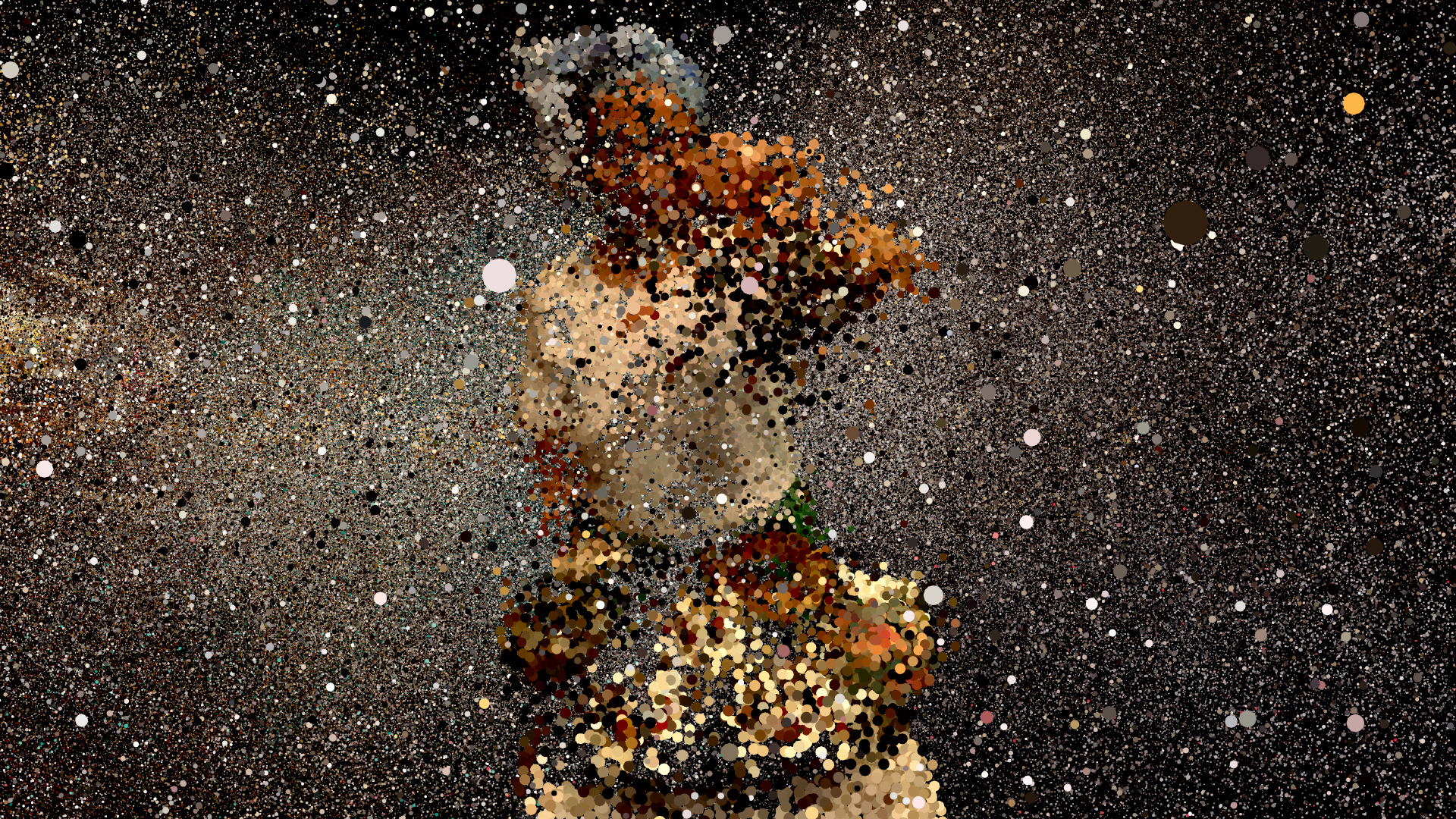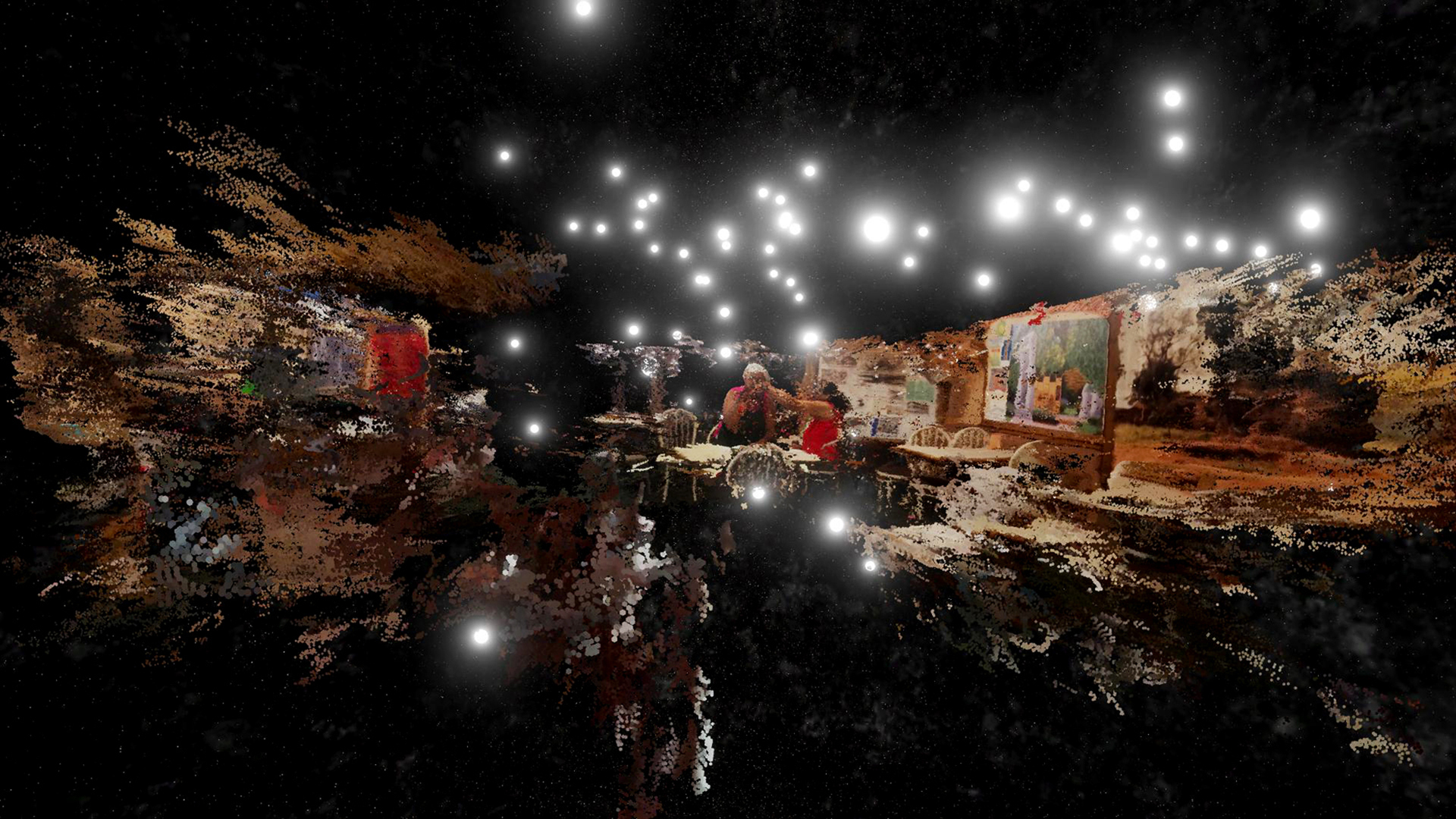Alumna Ainslee Alem Robson Releases Immersive Ferenj: A Graphic Memoir in VR
Ainslee Alem Robson, SCI-Arc alum (MS Fiction and Entertainment ’19), will soon release her immersive film experience, Ferenj: A Graphic Memoir in VR. Since graduating from SCI-Arc and completing the film, Ferenj was accepted into the SXSW Film Festival in Austin as well as the Cleveland International Film Festival, and has just been announced as having been accepted into the Tribeca Film Festival in New York. (Editor’s note: As of the writing of this piece, SXSW and the Cleveland Film Festival were canceled due to the coronavirus outbreak, but Tribeca will be held virtually.)

Set between her native Cleveland, Ohio and her mother’s native Addis Ababa, Ethiopia, Robson describes Ferenj as a “creative exploration of what it means for ‘home’ to be constructed immaterially via fragments of culture and oral history distorted by the filter of time and migration.” Employing crowdsourced data, photogrammetry, and game engine software to visually immerse viewers in a dreamscape of her melancholic childhood ‘tezeta’—meaning nostalgia in Amharic—Ferenj evokes the sights and sounds of Robson’s own formative cultural experiences growing up as an Ethiopian-American in Ohio.
A unique perspective from which Robson approached this project was that of someone who always felt, but couldn’t necessarily always identify, what she refers to as an “in-betweenness.” Having been raised in a first-generation family who ran—and still runs—Empress Taytu Ethiopian restaurant in Cleveland, Ohio, Robson’s experience of being mixed-race but also Ethiopian-American is the central conceptual principle that informed the creative development and execution of Ferenj.
To imbue the film with authenticity and a tangible sense of place, Robson collaborated with family and friends in the Ethiopian community in Cleveland, as well as those in Addis Ababa, asking them to send images and videos which she then processed and used to craft the visual landscape and narrative in the experience. Additionally, Robson curated a soundtrack comprised of Ethio-jazz tracks from the Éthiopiques album series produced by Francis Falceto, which preserved and popularized on a global scale forms of music from Ethiopia from the 1960s and 70s.
We spoke to Robson about what her process was like creating the film while at SCI-Arc, her personal motivations regarding the project, those involved in the making of the film, and the viewing community at large.

SCI-Arc: Hi Ainslee, thank you so much for speaking with us. First off, can you share how your interest in storytelling as a medium played a role in crafting the narrative of Ferenj?
Storytelling is for me a really empowering form of expression, because it allows me to access community that I don't necessarily have immediate access to by just sharing it with people, and by sharing my story with people, I’m able to see who relates and how people respond—which I love.
What was your creative process like, from the conceptualization through the production of this film?
During the concept development phase I was really influenced by looking at references of people who were using their own story to produce some type of creative output that wasn't necessarily limited to documentary. For example, I was looking at Issa Rae's YouTube series Awkward Black Girl, various standup comedy specials, like Mo Amer's Vagabond. I was paying attention to how they interpreted their story in a narrative form. In terms of the visual, I was focused on trying to find some type of style that conceptually complements what I was trying to talk about, which is this feeling of existing in between worlds.
Ferenj is also about memory and looking back to my childhood, so I was drawn to pointclouds because when you see them from afar they form an image, but when you get closer, they're more abstract. That also then lent itself to VR, and the possibility of being able to travel through the pointclouds.
In terms of navigating VR and the technical and technological aspects of creating a film in VR, what was it like developing the skillsets necessary for photogrammetry and pointclouds to produce an actual project?
I had to learn, first of all, what the heck a pointcloud was; what photogrammetry was. I think that was the benefit of [being at] SCI-Arc; all those resources are here.
Coming from a background in philosophy and French, it was a pretty intense transition to this type of an academic environment. I was used to: if I wanted to work hard on something, I'd just spent hours in the library. And I’d read and write and figure something out. But at SCI-Arc it's not like that, so it was hard to even figure out what my methodology would be. But Liam and Alexey both have experience with that. They pointed me to the right software and I experimented with different workflows.
How did you discover this VR as a medium as the avenue through which you wanted to make something? Had you had experience in it?
I had zero experience in VR, but one thing I really like about it is that something that people typically say is a weakness for VR, for me was a strength, which is that it's almost always a solitary viewing experience. And for me, I felt more comfortable being vulnerable and sharing such personal information knowing that people would view it in an an intimate, one-on-one setting.

What about pointclouds attracted you to using them to express this idea of living between worlds and how did this medium feel like the right one through which to explore your history and notions of otherness?
The characteristics align with some of the things that I feel, like not being able to reflect my authentic self to people in because of the ambiguous color of my skin. Like in Ethiopia for example, I don't necessarily look Ethiopian, so I feel that I cannot reflect my Ethiopian-ness, or what would be called my "Habesha-ness." Photogrammetry doesn't pick up reflective surfaces. It doesn't pick up mirrors. I have this bathroom scan—which didn't really make it into the experience—but there are two mirrors in that bathroom and a window, and there are three gaps in the shape of a mirror physically missing from the space. That seemed like such an oddly related detail and glitch in photogrammetry that's super specific to my experience, and that I really feel connected to in a weird way.
Also, when animated, they're always changing or in flux depending on where you are in relationship to them. This is very much akin to how I feel people perceive me in any given environment, which I think a lot of people can relate to on different levels; always changing, depending on the country, depending on the language, depending on the room, depending on the profession.
And so that speaks to racial impostor syndrome, which I just found out about a few months ago. I heard this NPR podcast called Code Switch. They had one episode where they talk about racial impostor syndrome—I think they coined the term. And this episode came out in the middle of when I was working on Ferenj last year. It's just one of those realizations that I'm continuing to have as a result of making this, and now I see that there's a simple phrase to explain this thing that I just built a whole experience trying to explain.
Can you share a bit about what was involved in deciding to delve into your life as an Ethiopian-American, as well as the choice to share personal elements of that experience?
Growing up in Cleveland, I had different types of community, but still had an alienated consciousness—I was, and am, in-between cultures and races. It was all either Ethiopian or American or either black or white. For most of my education, I was the only biracial/second-generation American/African in my class—and I was born in Cleveland.
Now the Ethiopian community in Cleveland is growing, but before it was just my family, our restaurant, and my parents’ friends. [When I was growing up] I would turn off my Ethiopian-ness and go to school then turn it back on hanging out in the kitchen of the restaurant and continue this cycle everyday. It’s pretty exhausting, and I wasn't even aware of it at the time. Even creating Ferenj has been a process of trying to analyze this cultural dissonance and understand what those dynamics actually were.
When was the first inkling that this was an experience that you had, and how and when were you able to identify that?
Well, when I was first at college, because that was the most diverse setting I had ever been in, academically or socially. Once I was out of the extreme cycle of rapid code-switching I could understand that I had been in it. I was thinking about these experiences while writing the script for Ferenj, and thinking about how and when I was in them or not in them, what I felt and the dynamics in between, and how I could translate that experience into a spatialized environment.
Much of the source material in the film is culled from videos you had family and friends send you from Ethiopia, as well as your family’s restaurant back home in Cleveland. Can you talk about how you came to this decision and what that collaborative process was like throughout the project?
I had lived in Ethiopia for almost 3 years after my college graduation. During the concept development phase, I knew I didn’t have the budget to keep flying back and forth between Addis, Cleveland, and LA. So I just contacted people in those locations and asked them to help me with the project.
That's another fascinating layer because you're working in communication rather than your own solitary archiving process. It then also contains an element of translation, from your request to their interpretation and then again as you work with what they’ve sent.
It was kind of funny because I was just asking people, "Hey, on your way to work, can you just stop by a taxi and walk around it and take a video in this certain way?" And people would then interpret that in different ways.The videos obviously weren't exactly how they were supposed to be, so when I processed them, they came out looking really fragmented which I ended up liking because I didn't have an expectation of it needing to look perfectly like reality.
Can you talk about your choice to focus on your family and friends throughout these collaborations? What are some of the conclusions that you were able to draw from that particular part of the process?
I'd have to call my mom and tell her to do this thing that and for her it felt really silly to just walk in a circle with her phone. But the fun part was being able to collaborate with family and friends, because I had an extra reason to call them, an extra reason to talk to them, to tell them about my project. Normally we wouldn't necessarily talk about the intricacies of what I'm doing day to day at school, but they were now my virtual production crew.
My family and the restaurant staff still have a hard time understanding what it is, but when I went home for the holidays this year, I actually took a computer and the headset and I showed them. They were just so in awe—for a lot of them it was their first time experiencing VR. I recorded the whole thing too.
Did you also find yourself personally impacted by these environments you’re creating using people and places in your life?
Yes, it all felt really dreamlike and incredibly nostalgic. It takes some time to get used to floating around 3D reconstructions of your living room miles away, your dog, or your mom.

What has your experience been like then presenting this very personal story that you have developed and are telling in this very personal way?
It's been rewarding, but it takes a lot of energy to be constantly able to talk about your feelings to teachers and other people around you in an academic setting, where normally you don't really need to share all of that. I just had to make sure I had a thick enough skin to be able to receive critiques and understand that that was about the project, not about what I did in my life, or the feelings I had about it.
It seems like people responded to it in a really connected way, even though you didn’t originally feel that Ferenj was the kind of project a student at SCI-Arc would make. Was there anything else particular to making this film in this environment that you noticed during the process?
I realized in the process of making it that I was building it for a white audience because that was mainly what was around me, who I was explaining it to at SCI-Arc. It was really hard in that there were only a couple of reviewers who asked, "Hey, did you think about how someone from your own perspective, or any perspective related to yours might respond to this?”
And that was a huge moment, to understand that I'd been trying to so hard to decenter whiteness in my narrative but I didn't even notice it creeping back in and taking up space because I've been programmed to position myself in relation to whiteness throughout life, and it didn't feel any different at SCI-Arc.
It sounds like that was the experience of otherness that you're speaking to within the film itself; that of feeling othered.
Yeah. Even while trying to speak to that I was missing this huge element until one reviewer came in and said, "You know, your story can be really intense for someone who relates to this, because I personally do,” and this person suggested that the film should have more moments of abstraction to let people cool off in between the intensity of relating to it. That was a really eye-opening moment and I had to sort of shift my strategy from that point on.
Absolutely. You write about this in the description of the film, but it's also very clear that you are confronting these ideas of whiteness and the white gaze being the pervasive or predominant aesthetic or conceptual framework through which people consume art and media. How did that change the way you now talk about and present this work?
It makes me feel more comfortable with it as a project, knowing that I had that realization before I finished. I don't think I would’ve wanted to share it otherwise.
You would feel like you missed something?
Yes, I would feel like I tried, but didn't reach my goal of decentering whiteness and creating an experience designed entirely around mixed-ness and Ethiopian-ness, which is what it's all about. It's surprisingly hard to do that because you have to first recognize that you’re not doing it then figure out how to do it.
You’ve mentioned that the score of the film is incredibly important to you. Can you talk about its role as well as the process in putting that together?
I'm so happy you asked that. In the beginning, I was really looking at [Sun Ra's] Space is the Place, and considering the idea of finding home in a genre of music. I feel like I find home every time I hear an Ethio-jazz song anywhere, so that needed to be the score for Ferenj.
I got to work with the musician Kibrom Berhane who is super talented and based in LA. With him we worked on some traditional instrumental recordings with the krar and masenqo.
I also found specific tracks that elevate the viewer’s emotional connection to the story if they understand the lyrics. The song in the trailer, “Teredtchewalehu” for example, is all about looking back to childhood as an adult with a new understanding, realizing the value of what their mother has done for them in their life. My mom was crying when she heard it. So far, everyone who understands Amharic who I've shown it said they had goosebumps hearing that music in the context of my story—I still tear up every now and then even after having heard it over and over during editing.
In another part, you see a lonely dog sitting in the snow as I’m talking about my mom in the narration. The song says, "alteleyeshignem…," which could be translated in context to, "you never left me, after all these years," and that’s sort of the voice of Ethiopia I imagine extending across the world to console her when she immigrated to America by herself.
How has creating this film at SCI-Arc shaped the experience of filmmaking for you? How will this carry over into the work that you continue to do?
I think because of SCI-Arc, I now feel that I can add visuals to my previously writing-only-based style of creativity. Going forward I think I'll draw from these types of skills, like being able to work in [game engine] Unity, and do photogrammetry.
I'll draw from these as tools to support a narrative film or project whenever it fits. I don't feel that I necessarily want to only work in game engine workflows. It's more so about how I can continue to make narratives that are interesting and use these types of techniques and tools to support the story.
Would your ideal be to be able to bring the film to Ethiopia?
Yes, I would love to take it to the Addis Foto Fest, one of the places where I worked when I was living there. I see photography as totally related to photogrammetry—it's another visual medium, it's about Ethiopia, and a lot of those photographers' work inspired me to even be interested in visual mediums of storytelling. So I think that would be really full circle.
—
Based in LA, Ainslee Alem Robson is a director, writer and media artist who crafts stories about tensions embedded within the intersectional layers of race, gender, perception, the digital, and nostalgia. With a background in philosophy she focuses on emancipatory narratives that deconstruct hierarchy and colonial legacies, and decenter Whiteness using emerging technologies in digital art. She penned an article in Offramp about Ferenj, which can be read online.